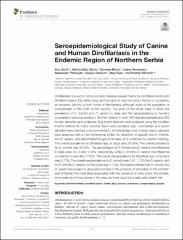| dc.description.abstract | Dirofilariasis is a vector-borne zoonotic disease caused mainly by Dirofilaria immitis and Dirofilaria repens that affect dogs and humans all over the world. Serbia is considered an endemic country to both forms of dirofilariasis, although most of the population is concentrated in the north of the country. The aims of this study were to show the prevalence of D. immitis and D. repens in dogs and the seroprevalence in humans compared to previous studies in Northern Serbia. In total, 346 dog sera samples and 265 human samples were analyzed. Dog blood samples were analyzed using the modified Knott's method to check whether there were Dirofilaria spp. microfilariae and serum samples were checked by a commercial D. immitis antigen test. Human serum samples were analyzed with a non-commercial ELISA for detection of specific anti-D. immitis, anti-D. repens, and anti-Wolbachia IgG antibodies, and confirmed by western blotting. The overall prevalence for Dirofilaria spp. in dogs was 29.19%. The overall prevalence for D. immitis was 26.30%. The percentages of D. immitis and D. repens microfilaremia in dogs were 25.72 and 1.45%, respectively, while D. immitis./D. repens microfilaremia co-infections were also 1.45%. The overall seroprevalence for Dirofilaria spp. in humans was 3.77%. The overall seroprevalence for D. immitis was 1.51, 1.13% for D. repens, and for D. immitis/D. repens co-infections was 1.13%. The results indicate that D. immitis and D. repens are present in dogs and humans in the province of Vojvodina, in the northern part of Serbia. It is most likely associated with the presence of many rivers, the climate, and presence of mosquitoes in the area, so there could be a real public health risk. | en_US |

